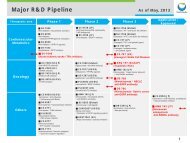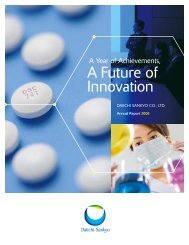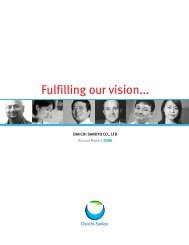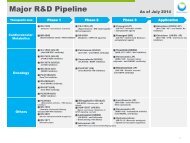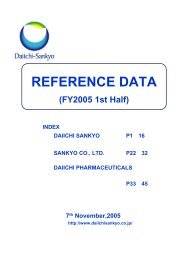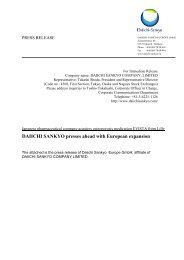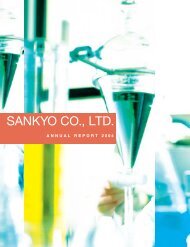Annual Report 2009 - Daiichi Sankyo
Annual Report 2009 - Daiichi Sankyo
Annual Report 2009 - Daiichi Sankyo
Create successful ePaper yourself
Turn your PDF publications into a flip-book with our unique Google optimized e-Paper software.
The hybrid business model offers at least two kinds of concrete<br />
benefits.<br />
Expansion of Global Reach<br />
By interlinking with Ranbaxy’s network, <strong>Daiichi</strong> <strong>Sankyo</strong> has dramatically<br />
extended its global reach and built a marketing network<br />
that can cover many emerging countries to which it did not previously<br />
have direct access. As a result, we are now able to increase<br />
our presence in a wide range of areas throughout the world,<br />
including emerging country markets.<br />
In addition, by adding generic products previously absent from<br />
its product lineup, <strong>Daiichi</strong> <strong>Sankyo</strong> can take full advantage of<br />
strengths stemming from an abundant array of offerings and a<br />
marketing network that covers 56 countries as it strives to provide<br />
the drugs needed by patients in each area of the world.<br />
Realizing an Efficient Value Chain<br />
As in other fields, global competition is intensifying in <strong>Daiichi</strong><br />
<strong>Sankyo</strong>’s core business of R&D and manufacturing operations<br />
related to proprietary drugs, and this competition makes it<br />
extremely important for the Company to further increase its productivity.<br />
India-based pharmaceutical companies have earned<br />
high evaluations for their cost competitiveness and quality assurance<br />
capabilities as well as their excellent performance as a<br />
partner for pharmaceutical companies based in various other<br />
countries, and Ranbaxy is no exception.<br />
Ranbaxy has many outstanding researchers engaged in creating<br />
innovative drugs and novel drug delivery systems as well as<br />
participating in cooperative research programs with global companies<br />
such as GlaxoSmithKline plc and Merck & Co., Inc.<br />
Furthermore, it has superior cost competitiveness backed up by<br />
solid manufacturing technologies.<br />
By putting these resources with great potential to good use,<br />
<strong>Daiichi</strong> <strong>Sankyo</strong> can build a highly efficient value chain for all<br />
processes from research through marketing and accelerate its<br />
creation and provision of innovative drug products.<br />
Overcoming Challenges and Harvesting<br />
Results<br />
In September 2008, the U.S. Food and Drug Administration (FDA)<br />
issued warning letters to Ranbaxy regarding current good manufacturing<br />
practice (cGMP) violations at two of its plants in India—<br />
Paonta Sahib and Dewas—and import alerts restricting products<br />
produced at those facilities. In addition, in February <strong>2009</strong>, the FDA<br />
moved to invoke its Application Integrity Policy (AIP) against the<br />
Paonta Sahib facility, raising questions about the integrity of data<br />
in Abbreviated New Drug Applications (ANDAs)* from that plant.<br />
Ranbaxy and the <strong>Daiichi</strong> <strong>Sankyo</strong> Group take this issue very<br />
Ranbaxy’s head office, Gurgaon, India<br />
Global Reach<br />
16<br />
<strong>Daiichi</strong> <strong>Sankyo</strong> Co., Ltd. <strong>Annual</strong> <strong>Report</strong> <strong>2009</strong>




